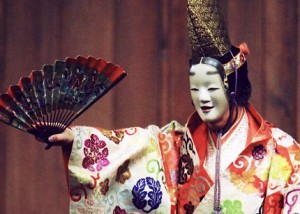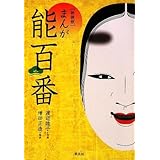 「能」は日本の伝統芸能のひとつです。独特なリズムの音曲に合わせて、面をつけた役者が舞う姿によって人生の喜怒哀楽を表現します。
「能」は日本の伝統芸能のひとつです。独特なリズムの音曲に合わせて、面をつけた役者が舞う姿によって人生の喜怒哀楽を表現します。
これは奈良時代に中国から伝来した「散楽」という歌謡や舞踏、物真似などを披露する民間芸能が源流と言われています。それが寺社の保護を受けて、祭礼に奉納する「猿楽」へと発展していきます。
室町時代に、将軍・足利義満の庇護を受けた観阿弥・世阿弥の親子が、当時流行っていた音曲を取り入れ、歌舞主体の演芸を創り上げました。この演芸が、現在まで伝わっている能の原型です。
英訳
Noh is Japanese oldest form of musical dance-drama. The Noh actors wear rich, heavy, ancient costumes and masks. They express emotions only through dancing and gestures. Accompaniment is provided by traditional instruments such as drums(Tsuzumi and Taiko) and flutes(Nokan).
Noh is originally known as sangaku or funny parodies. It was brought from China to Japan around the beginning of the 8th century. It gradually became a more subtle and profound story-telling art form. In the 14th century, a father and son combination named Kan’ami and Zeami that were patronized by third Muromachi shogun, Ashikaga Yoshimitu established the stylized tradition known today as Noh. While Kabuki was for the common people, Noh was a ceremonial drama performed on auspicious occasions for the warrior class.
by blogger
中国語訳
“能乐[1]”是日本传统的艺术形式之一。演员随着独特韵律[2]的音乐,戴[3]着面具用舞姿[4]来表演人生喜怒哀乐[5]的一种表演艺术。
据说“能”是在奈良时代[6]从中国传来的。其[7]源流[8]是叫做“散乐[9]”的歌谣[10]、以及舞蹈[11]、口技[12]等民间文艺。散乐得到寺院[13]和神社[14]的重视,发展为祭礼[15]供奉[16]的“猿乐[17]”。
在室町时代,受到将军[18]足利义满[19]庇护[20]的观阿弥[21]、世阿弥[22]父子,采纳当时流行的音乐,创造出以歌舞为主体的表演艺术。这种演艺就是现在的“能”的原型。
新浪博客版
1 能乐 Néngyuè 能、能楽
2 韵律 yùnlǜ リズム
3 戴 dài つける、着る
4 舞姿 wǔzī 舞う姿
5 喜怒哀乐 xǐnù āilè 喜怒哀楽
6 奈良时代 Nàiliáng shídài 奈良時代
7 其 qí その
8 源流 yuánliú 源流
9 散乐 sànyuè 散楽
10 歌谣 gēyáo 歌謡
11 舞蹈 wǔdǎo 舞踏
12 口技 kǒujì 物真似
13 寺院 sìyuàn 寺
14 神社 shénshè 神社
15 祭礼 jìlǐ 祭礼
16 供奉 gòngfèng 奉納
17 猿乐 yuánlǜ 猿楽
18 将军 jiàngjūn 将軍
19 足利义满 Zúlì yìmǎn 足利義満
20 庇护 bìhù 庇護
21 观阿弥 Guān āmí 観阿弥
22 世阿弥 Shì āmí 世阿弥
関連記事
・日本文化 狂言 ・日本文化 歌舞伎
・能を庇護した将軍・足利義満 ― 室町幕府はトホホな将軍が多すぎ!!
・日本文化一覧
・日本史 年代別記事一覧
 |
新品価格 |
![]()

